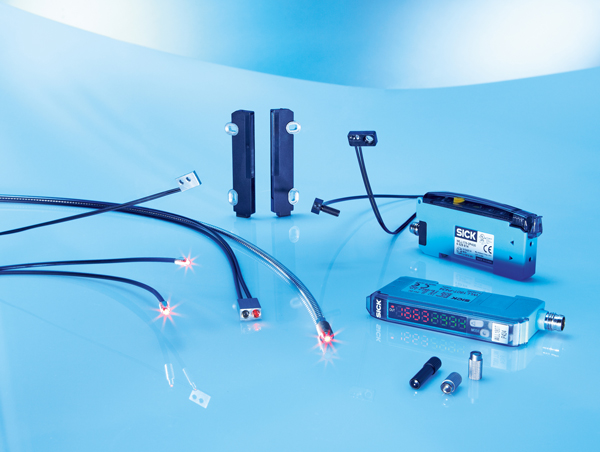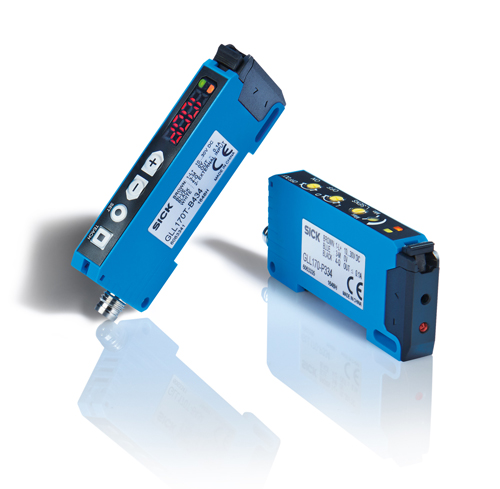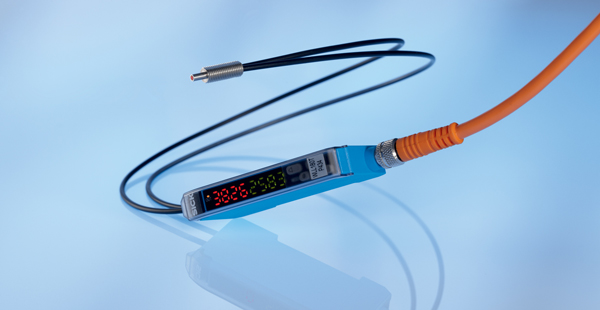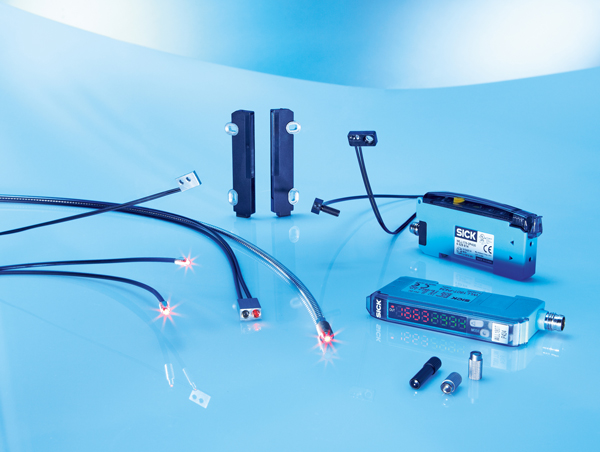Very low installation space required, flexible use in the smallest of corners, the right functionality for standard and special requirements and versatile application possibilities – this is what fiber-optic sensors from SICK stand for. Whether as a scanner or as a through-beam light barrier, the large number of fiber-optic versions and end sleeve options provides a suitable automation solution for nearly any working environment.
In addition to these are amplifiers with integrated senders and receivers whose performance features and technical automation equipment are tailored to both challenging applications and – such as the new GLL170 product family – to versatile and economically-efficient standard applications. Glass or plastic fibers, thread, straight or long sleeves, straight or 90° angled light emission, flat design for point detection and area detection with line-shaped light spot, highly-flexible fiber optics with small bend radii, chemical-, oil- and heat-resistant sheaths of the fiber cores made of plastic, metal or Teflon: The combination of these features show how wide the area of application of these sensors is. This includes electronics and solar production, the semiconductor industry, packaging machine construction, handling and mounting systems, the wood processing industry and a wide range of fields in special mechanical engineering.
Fibers – specialists for special requirements
When the installation space at the detection site of a machine is not large enough even for a miniature sensor, fiber-optic sensors are often the only option for detecting objects. The separation of optics and evaluation make it possible to come very close to the detection object both with scanners and with through-beam systems; at this site, only a few square millimeters of installation space or free light path are available due to the machine construction. When using highly-flexible fiber-optics or variants with diverted light emission, technically and economically-efficient solutions can be implemented even under unfavorable installation conditions. High temperatures as well as aggressive oils and chemicals or mist coming off of these at the detection site are additional application conditions in which the appropriate versions of fiber-optic sensors are used. Both with hidden and invisible mounting and with heavy-duty boundary conditions, fiber-optic sensors often have the decisive advantage that their amplifiers can be installed at easily-accessible places. This means the sensor is accessible and operable at all times for operating and maintenance staff. In addition to the user-friendly application during commissioning and in practical use, fiber-optic sensors – just like conventional photoelectric sensors – cover the entire range of performance features thanks to their amplifiers. The application determines the use of potentiometer or teach-in setting and the switching frequency depending on the given object speed or desired detection speed. Operating modes such as a release delay and different switching outputs – which can be selected on the amplifier as needed – are available, as are versatile connectivity options. Fieldbus connections therefore have the advantage of offering complete read and write access to all parameters of the fiber-optic sensors from the control. That means settings do not have to be made directly on the device – and information such as switching outputs, light reception values or set parameter configurations can be output directly to the automation system. Fiber-optic sensors thereby also offer unrestricted solutions for automation technology, and prove themselves to be specialists for special requirements at the same time.
New GLL170T amplifier: PNP and NPN output types in one sensor
The new GLL170 fiber-optic amplifier is even easier to operate and offers an even higher level of flexibility. With both the GLL170 variant with potentiometer and the GLL170T teach-in version with digital display, the user can flexibly adjust the sensor parameters to the application. Both amplifier versions fulfill the requirements of enclosure rating IP66 even without a rear cover. This means they can be installed directly on the machine, and this can be done with great variability using either mounting rail supports or fixing holes in the housing. The teach-in variant features two special highlights: It offers both PNP and NPN output types in one sensor, making it suitable for machines both in European and overseas markets. In addition, its alpha-numeric display makes monitoring of process parameters simple. Together, the market-tested WLL180 amplifier for challenging applications and the GLL170 product family for versatile and economically-efficient standard applications cover nearly any requirement on the application and automation technology.
Semiconductor, electronics and solar: Fibers detect with line-shaped light spot
Compact machines and transport modules are standard in the semiconductor, electronics and solar industry – this is therefore a wide field of application for fiber-optic sensors. For example, they are used to check the positioning of wafers, monitor the height of wafer stacks, detect lead frames or substrate carriers in hot wire bonding environments or to capture the leading edge of printed circuit boards. Since these are often thin objects or objects with a flat edge, scanners or through-beam systems with an array-type light emission are often used. During processing, the challenge is reliably detecting printed circuit boards only 0.2 millimeter thick, sometimes with curved or bent leading edges. The task is completed with a new GLL170T amplifier and LL3-TS05 fiber optics with array optics. The sensor projects a light beam in the area through which the printed circuit board is transported. In contrast to point detection, the task is done here with a line-shaped light spot. This ensures that the leading edge of the printed circuit board is reliably detected in any position within an array of about five millimeters.
Battery production: Safe detection of double-layer separator films
In the highly-automated production process of batteries for electromobile vehicles, it must be ensured that only a single separator film is inserted between two conducting elements. If two or more films are applied per layer, this increases the internal resistance of the battery, which results in adverse effects on the performance data, the capacity and, under certain circumstances, the packing density of the battery. To prevent production errors caused by multiple-layered separator films, a WLL180T amplifier as well as a fiber-optic through-beam system with M4 threaded sleeve is used. Due to its high light intensity and its high-resolution signal processing, this sensor offers the option of evaluating the attenuation of the light beam through the separator film. More than one film layer means attenuation above the programmed threshold value or blocking of the light path – the fiber-optic sensor detects the double layer, thereby preventing the production of faulty batteries.
Packaging technology: High process reliability at high speeds
A machine engineering company for the tissue and hygiene industry manufactures tissue machines with integrated single and container packers which can produce almost 5,000 tissues per minute. The reliability of the sensors at such high speeds and production quantities is extremely important. After smoothing and pressing the tissues (up to four layers in height), the compressed sheet of tissues goes through the cutting, folding, and stacking module of the machine, where it is slit, folded, and fed to a stacking magazine, from which it is then transported to the packaging module in piles. The machine manufacturer created a shaft and congestion monitoring point on the stacking unit with a WLL180T fiber-optic amplifier. Further aspects in favor of these sensors include their compact size, fast response times of just 16 µs, and high light intensity and resolution, which ensures an additional operating reserve in this dusty operating environment.

Timber industry: Fiber optics withstand dust and shavings
Fast, safe, and efficient production processes are indispensable for high productivity in the saw mill, wood material, veneer, and furniture industries. Dust, particularly shavings, make wood-processing machines a particular challenge for opto-electronic sensors in general. Fiber-optic sensors, which, for example, are used to position trunks in front of saws or slats in front of stacks, are able to blank out such disturbance variables of reliable object detection. A through-beam system with a metal M12 threaded sleeve, an optical lens integrated in the fiber-optic head for strong focusing of the light beam and a fiber-optic amplifier with high transmitting power provide the mechanical and optical ruggedness needed for this environment. The special beam array and, if necessary, the setting of a switch-off delay ensure that foreign bodies in the light path do not result in false switching signals.Fiber optics made of plastic or glass fibers – if necessary in rugged sheaths, a wide variety of models and with amplifiers for different automation requirements – are the basis for fiber-optic sensors which enable a wide range of application-specific solutions with high reliability and availability.





